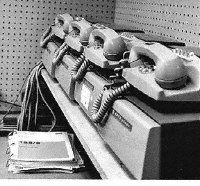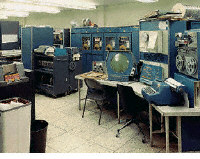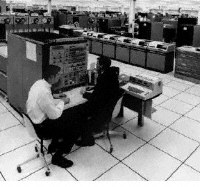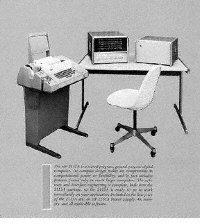|
1960
- AT and T Dataphone

AT
& T Dataphone
(Image
courtesy of Computer History Museum)
This was
designed as the first commercial modem, specifically for converting
digital computer data to analog signals for transmission across
its long distance network. (Computer History Museum).

John
Silk talks about the use of punchcards at ICI in the Agrochemical
department
1960
- DEC PDP-1
The precursor
to the minicomputer, one of these would have sold for $120,000!
(Computer History Museum)

DEC
PDP-1
(Image
courtesy of Computer History Museum)
1960
- Software Languages
The developments
in the stored program and programming languages such as COBOL
(Common Business Orientated Language) aimed for easy readability
of computer programs and as much machine independence as possible.
Such languages enabled computers to be cost effective and productive
for business use.
1961
- John Kennedy
President
John Kennedy's challenge to put a man on the moon and return him
safely by the end of the decade transformed the US space program
into a complex of research and production centres with unlimited
budgets and insatiable appetites for computing power. (Ceruzzi.
P., 1998).

1961
- Clive Tomlin remembers a mainframe computer in a research centre
in America
1961
- UNIMATE
The first
industrial robot began work at General Motors obeying step-by-step
commands stored on a magnetic drum, the 4,000 pound arm sequenced
and stacked hot pieces of die-cast metal.

UNIMATE
(Image
courtesy of Computer History Museum)
1962
- SPACEWAR!
This was
considered the first interactive computer game, inspiring the
development of future video games, arcade games and games consoles.
It was first played on the DEC's PDP-1. (Computer History Museum)
1963
- Rancho Arm
Designed
at Ranch Los Amigos Hospital, California. The idea behind this
mechanism is a tool for the disabled. The arm has six joints that
enables it to have the 'flexibility' of a human arm.

John
Silk explains the problem of expanding chemical literature and
how it led ICI into using computers
1964
- IBM System/360

IBM
System / 360
(Image
courtesy of Computer History Museum)
This year
saw the development of six mutually compatible computers and forty
peripheral's that could work together. Orders for the system reached
1,000 per month by 1966. (Computer History Museum)
Mid
1960s - The Minicomputer
Increased
demands by well funded customers and advances in research into
solid state physics, electronics and computer architecture led
to the creation of the minicomputer. This was not a direct competitor
to mainframes, but it opened up new areas of applications. It
introduced large numbers of groups, at first engineers and scientists,
to direct interaction with computing machines. They created the
notion of the computer as a personal interactive device. (Ceruzzi.
P., 1998).
Although
minicomputers established a market in the 1960s, most computer
dollars continued to be spent on large mainframes sold by IBM
and its few competitors. (Ceruzzi. P., 1998).
1966
- Hewlett Packard
This company
entered into the general purpose computer business with the HP-2115.

Hewlett
Packard HP-2115
(Image
courtesy of Computer History Museum)
1968
- Apollo Guidance Computer
This made
its debut orbiting the Earth on Apollo 7. In 1969 it steered Apollo
11 to the lunar surface.
1968
- ICL
International
Computers Limited (ICL) was a creation of ICT (International Computers
and Tabulators) coming together with English Electric. Previous
mergers and absorption of companies by ICT and English Electric
now led to all the major British computer manufacturers under
one roof.
Historically
ICL contained a large component of punch card equipment manufacturing,
sales of this equipment took a long time to fell the impact of
stored program digital computers. (Lavington. S., 1980).
Late
1960s - Mainframes
Timesharing
for mainframes was developed. (The History of Computing Project.,
2002). For economic reasons a mainframe could not be dedicated
to a single user, in practical terms the only way to use a large
machine interactively was for several users to share its computational
cycles, or 'time' simultaneously. (Ceruzzi. P., 1998).
|

![]()
